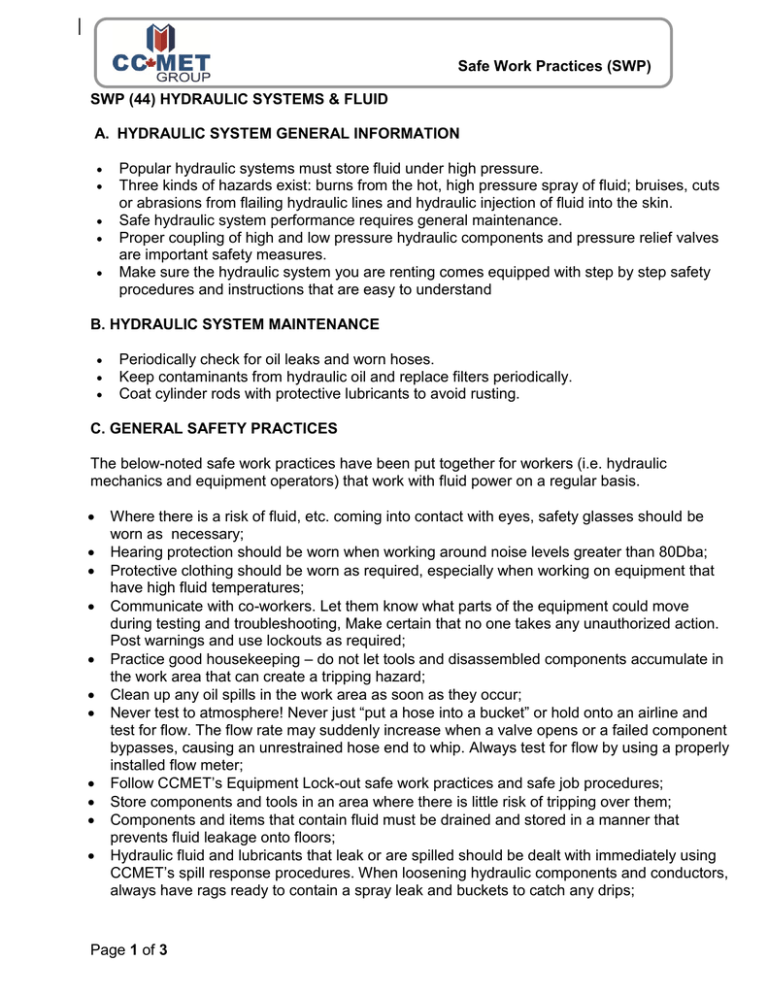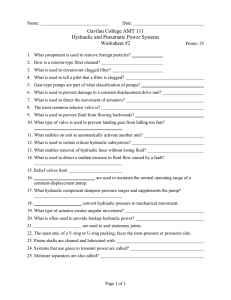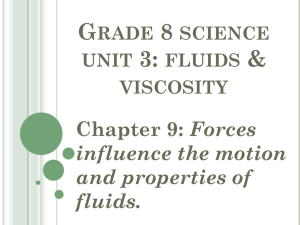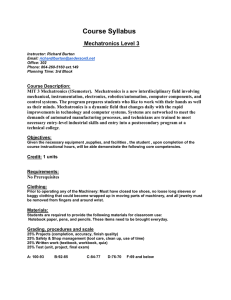Hydraulic Systems Safe Work Practices (SWP)
advertisement

Safe Work Practices (SWP) SWP (44) HYDRAULIC SYSTEMS & FLUID A. HYDRAULIC SYSTEM GENERAL INFORMATION Popular hydraulic systems must store fluid under high pressure. Three kinds of hazards exist: burns from the hot, high pressure spray of fluid; bruises, cuts or abrasions from flailing hydraulic lines and hydraulic injection of fluid into the skin. Safe hydraulic system performance requires general maintenance. Proper coupling of high and low pressure hydraulic components and pressure relief valves are important safety measures. Make sure the hydraulic system you are renting comes equipped with step by step safety procedures and instructions that are easy to understand B. HYDRAULIC SYSTEM MAINTENANCE Periodically check for oil leaks and worn hoses. Keep contaminants from hydraulic oil and replace filters periodically. Coat cylinder rods with protective lubricants to avoid rusting. C. GENERAL SAFETY PRACTICES The below-noted safe work practices have been put together for workers (i.e. hydraulic mechanics and equipment operators) that work with fluid power on a regular basis. Where there is a risk of fluid, etc. coming into contact with eyes, safety glasses should be worn as necessary; Hearing protection should be worn when working around noise levels greater than 80Dba; Protective clothing should be worn as required, especially when working on equipment that have high fluid temperatures; Communicate with co-workers. Let them know what parts of the equipment could move during testing and troubleshooting, Make certain that no one takes any unauthorized action. Post warnings and use lockouts as required; Practice good housekeeping – do not let tools and disassembled components accumulate in the work area that can create a tripping hazard; Clean up any oil spills in the work area as soon as they occur; Never test to atmosphere! Never just “put a hose into a bucket” or hold onto an airline and test for flow. The flow rate may suddenly increase when a valve opens or a failed component bypasses, causing an unrestrained hose end to whip. Always test for flow by using a properly installed flow meter; Follow CCMET’s Equipment Lock-out safe work practices and safe job procedures; Store components and tools in an area where there is little risk of tripping over them; Components and items that contain fluid must be drained and stored in a manner that prevents fluid leakage onto floors; Hydraulic fluid and lubricants that leak or are spilled should be dealt with immediately using CCMET’s spill response procedures. When loosening hydraulic components and conductors, always have rags ready to contain a spray leak and buckets to catch any drips; Page 1 of 3 Safe Work Practices (SWP) Many hydraulic fluids are flammable, ensure a fire extinguisher is kept close at hand when performing repairs and preventative maintenance to equipment; If you cannot identify the safe working pressure of a component or fluid conductor, do not use it. If you don’t know the working pressure of a system, find out, and use only components and fluid conductors that are rated for or above this working pressure; Fitting types should be matched carefully as some “o ring” fittings and pipe fittings can be assembled mismatched – they can leak, spray dangerous jets of fluid, or blow out of the other fitting or boss; Fluid injection through skin is a danger to all persons using hydraulic fluid or any material that is pressurized. Pressures in the range of 400PSI or higher, depending on conditions, can cause injections. An injury caused by pressurized fluids IS SERIOUS. If you are injured or even suspect an injury, go to the Emergency Room immediately; Fluid injection through skin can come from a crack in a component, fitting or fluid conductor. It can also come from a pin hole in a hose, from between bolted flanges, from a loose fitting, from a failed seal or from a component or conductor that burst. Other sources of injection hazard are pressure cleaning systems, grease/lubrication dispensing systems and airless spray paint systems; Never place your finger, hand or any part of your body in front of a fluid spray or dispensing gun. Never clean yourself with a pressure washer or pneumatic blow gun. Never tighten a leaking fluid conductor or bolted flange while the system is pressurized. (The additional stress of tightening can cause a burst type failure.); Safety-case type gauges should be used wherever possible to prevent the chance of air from being inside cylinders after a repair; Always assume pressure is present. (i.e. charged accumulators, loaded actuators); Never tighten or loosen lines while the system is still operating; Do not use compressed air to blow pistons out – it is very dangerous because the piston will turn into a flying projectile; Always use a winch to pull apart hydraulic cylinders. Do not used compressed air. Do not partake in welding, cutting, brazing, burning on a piece of hydraulic equipment that has had reservoirs, tanks, drums containing a combustible material; High pressure leaks can turn into a blow torch if ignited! If the leaking oil is hot, severe burns can result; Never place your hand or finger on a rotating part of the hydraulic equipment; Keep clothing and cleaning towels away from rotating parts; Troubleshooting a machine that has an interrupted machine cycle may result in personal injury or machine damage. Make sure you study the machine and make certain that tools, equipment and persons are clear of possible damaging motion should an actuator move. Check for safe and clear operation any time you do anything that could cause actuators to move; Never place yourself on either side of a compactor piston, a mold, die, clamp, jaws, or any parts that could move and pinch or crush you; Working on a system that has not been depressurized can produce a major oil spill; Carry out maintenance or repairs on a properly locked-out, blocked machine. Ensure no other vehicle will be operated in that area; Hydraulic systems and compressors can run hot. Always touch lightly and carefully at first, Page 2 of 3 Safe Work Practices (SWP) using the back of your hand – use gloves/hand protection if you cannot wait for the system to cool down; In hose applications, use nonconductive hose on boom trucks. Contact with electrical lines can be deadly; Pumps and motors should not be picked up or held by the shaft. Keyways are extremely sharp and can cause deep cuts; Do not carry parts with oily hands – they can slip out of your grasp and cause a foot injury; Always wear Personal Protective Equipment when working with cleaning or hydraulic fluids; Wear respirators when there is a chance of coming into contact with fumes, spray mist and dust; Outriggers or stabilizers that are outfitted with pilot operated check valves can trap pressurized fluid. Removing valves to relieve pressure is very dangerous. Jets of fluid, seals or propelled parts may injure you. Page 3 of 3





